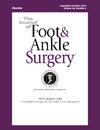Post-treatment Functional Outcomes of Distal Tibiofibular Syndesmosis Injuries With Varying Duration and Method of Stabilization
IF 1.3
4区 医学
Q2 Medicine
引用次数: 0
Abstract
The purpose of this study was to assess whether the type and duration of screw fixation affects ankle joint functional scores and patient activity levels. We evaluated 55 patients who had undergone surgical treatment for ankle fracture with concomitant distal tibiofibular syndesmosis injury. The follow-up period ranged from 2 years to 4 years and 2 months (mean 36 months). Depending on the time of screw removal, patients were divided into 2 groups (the 8–15-week group-19 patients, and the 16–22-week group-36 patients). There were 17 patients with tricortical and 38 patients with quadricortical syndesmosis fixation. The following parameters were assessed: range of motion, rates of complications, level of pain in visual analogue scale (VAS), and function. In the quadricortical fixation group the range of plantar flexion p = .04 and adduction p = .043 were significantly lower in the operated than in the nonoperated limb. In the patients who had their syndesmotic screws removed after 16–22 weeks, the range of plantar flexion in the operated limb was significantly lower than that in the nonoperated limb. We observed no differences between the evaluated groups in terms of ankle joint mobility, VAS pain levels, functional outcomes, or complication rates. All the analyzed subgroups showed poorer ranges of some types of motion in the ankle and worse functional scale and VAS pain scores after treatment in comparison with those before the injury. We suggest removing the syndesmotic screws after 8–15 weeks, due to the possibility of earlier rehabilitation, faster return to work and physical activity and less burden on the health care system. Tricortical or quadricortical syndesmosis fixation is at the surgeon's discretion.
胫腓骨远端联合韧带损伤治疗后的功能效果,治疗持续时间和稳定方法各不相同。
本研究旨在评估螺钉固定的类型和持续时间是否会影响踝关节功能评分和患者的活动水平。我们对 55 名接受过踝关节骨折手术治疗并同时伴有胫腓联合远端损伤的患者进行了评估。随访时间从 2 年到 4 年零 2 个月(平均 36 个月)不等。根据取出螺钉的时间,患者被分为两组(8-15 周组--19 名患者,16-22 周组--36 名患者)。其中,17 名患者接受了三皮质巩膜固定术,38 名患者接受了四皮质巩膜固定术。对以下参数进行了评估:活动范围、并发症发生率、视觉模拟量表(VAS)显示的疼痛程度以及功能。在四侧皮质固定组中,手术肢体的跖屈范围 p=0.04 ,内收范围 p=0.043 明显低于非手术肢体。在16-22周后取出联合螺钉的患者中,手术肢体的跖屈幅度明显低于非手术肢体。我们观察到,在踝关节活动度、VAS 疼痛水平、功能结果或并发症发生率方面,各评估组之间没有差异。与受伤前相比,所有被分析的亚组在治疗后踝关节某些类型的活动范围更小,功能量表和 VAS 疼痛评分更差。我们建议在 8-15 周后移除联合韧带螺钉,因为这样可以提前康复,更快地恢复工作和体力活动,并减轻医疗系统的负担。三皮质或四皮质巩膜固定由外科医生决定。临床证据级别:3级,病例对照研究。
本文章由计算机程序翻译,如有差异,请以英文原文为准。
求助全文
约1分钟内获得全文
求助全文
来源期刊

Journal of Foot & Ankle Surgery
ORTHOPEDICS-SURGERY
CiteScore
2.30
自引率
7.70%
发文量
234
审稿时长
29.8 weeks
期刊介绍:
The Journal of Foot & Ankle Surgery is the leading source for original, clinically-focused articles on the surgical and medical management of the foot and ankle. Each bi-monthly, peer-reviewed issue addresses relevant topics to the profession, such as: adult reconstruction of the forefoot; adult reconstruction of the hindfoot and ankle; diabetes; medicine/rheumatology; pediatrics; research; sports medicine; trauma; and tumors.
 求助内容:
求助内容: 应助结果提醒方式:
应助结果提醒方式:


